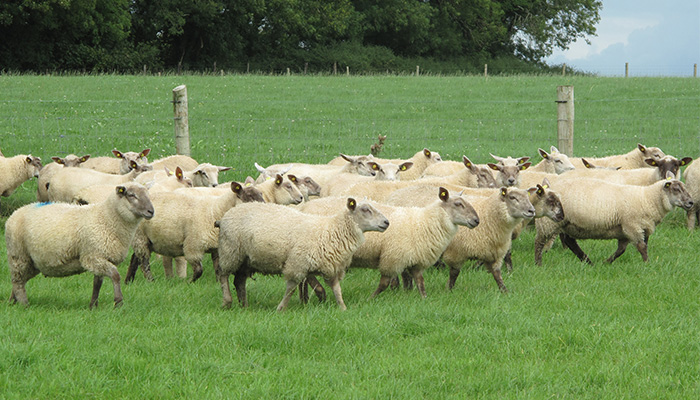17 August 2023
Challenging season for finishing lambs

Ciaran Lynch, Teagasc Sheep Specialist, reports on the many challenges this season has thrown up for lamb finishing and explains why putting a plan in place is critical when managing the remaining lambs on your farm this season.
The lower performance reported on farms in the early part of the season combined with difficult weather since weaning has had an impact on lamb thrive and consequently drafting.
Low grass dry matter in recent weeks has had an adverse impact on intake and consequently energy consumed, thus reducing lamb performance. When this is combined with declining sward quality and less available aftergrass due to delayed cutting of first/second cuts, the issue is compounded.
This has been reflected in the national kill, with approximately 40,000 less spring-born lambs finished to date. This poses a challenge for farms as we head into the autumn carrying larger numbers of potentially lighter lambs.
Although the extent of the impact on lamb performance has been variable among farms this season, it’s important to take stock of the remaining lambs and weight or stage of finish they have currently reached.
By weighing a cross section of lambs, you will have a good gauge to then estimate how many of the remaining lambs fall in to the following categories for finishing: short term 40 kg+; medium term 35-40kg; and longer term lambs that are less than 35 kg. Be realistic about finish times for these lambs and see how this weighs up against previous seasons. Reviewing previous years drafting patterns versus the current season will give a good indication of this year’s performance and also what the farm can carry into the autumn.
Putting measures in place
Many farms will have the capacity to carry lambs into the autumn, but they need to put measures in place to deal with additional numbers. The first step in this is to ensure sufficient grass for the coming weeks by applying fertiliser where needed when conditions allow. Better responses will be achieved with August applications rather than waiting for closer to the fertiliser deadline.
Post weaning, lambs will typically achieve growth rates from 200 g/day declining to 150 g/day, or 1.5 to 1kg gain per week from July through to early September. However, to date and perhaps unsurprisingly given the recent weather conditions, these growth rates are not being met. Supplementation will by now have been introduced on most farms to a portion of the lambs. A number of farms will operate finishing groups (i.e. lambs within 5-10 kg of drafting weight) post weaning.
The level of concentrate supplement needed will vary depending on each farm’s situation. As a simple rule of thumb, as feed level increases so does performance and daily cost of supplementation whilst feed conversion declines. Whilst ad-lib feeding in creep feeders will offer high performance and a certain convenience, it does represent a costly way of finishing.
Trough feeding will allow all lambs access to the same level of feed at once; feed rates of up to 0.5kg in a single fed will deliver improved performance with good levels of efficiency. In circumstances where lamb drafting has been slow, upping this to 1kg – split into twice daily feeds – to a finishing group will move this group faster, but this need to be targeted at lambs close to finish to keep costs in-check. Similarly on farms where overall lamb weights/drafting is back, introducing feed to the follow on group at a rate of 0.3-0.5kg a day may be necessary this season to counteract the earlier setbacks.
Weigh up the selling options particularly on farms where large number of lambs are remaining. For some farms, selling a portion of stores may be an advisable option. Whether this be from the lighter or heavier portion will vary on individual farm circumstance, but it’s an option that could be considered this season to reduce demand and provide a welcome income stream.
Take care when drafting
Another consequence of lower performance in lambs this season is reflected in the increased number of lighter, under-fleshed lambs (16-17kg and fat class 1 lambs) being presented to abattoirs in recent weeks. These are posing challenges for processors to market and are not achieving their potential for farmers that supplied them.
These lambs may have been better suited to the live trade or received further feeding. Consider drafting weight and how the lamb handles when selecting lambs. Take into account that when drafting that lamb, kill-out will decline as the season progresses. March-born lambs are now between 20 and 24 weeks old, typically these should have an average kill out of 42-43% at this point in the season. So for example, to achieve a 20kg carcass, lambs would need to be drafted 47.5kg with adequate cover. However, lambs that do not handle well – even at this drafting weight – may need to be pushed further to achieve higher carcass weights, correspondingly better conformed, fleshed lambs will have better kill outs. Other factors such as breed, gender and level of feed will influence lamb kill out and need to be considered when drafting lambs.
This is a season to double down on the basics, managing grass supplies, monitoring parasite burden, keeping lameness at bay and supplementing cobalt where and when needed to avoid any further setbacks. Most of all, assess the current situation on your own farm and put a plan in place to manage the remaining lambs this season.
Planning for the autumn
Dr Philip Creighton, Teagasc Sheep Enterprise Leader, is on this week’s OviCast to discuss planning for the autumn ahead. Joining Teagasc Sheep Specialist Ciaran Lynch, they discuss the impact poor grazing conditions have had on lamb performance this year and the knock-on effect this has on management for the autumn. Listen in below:
